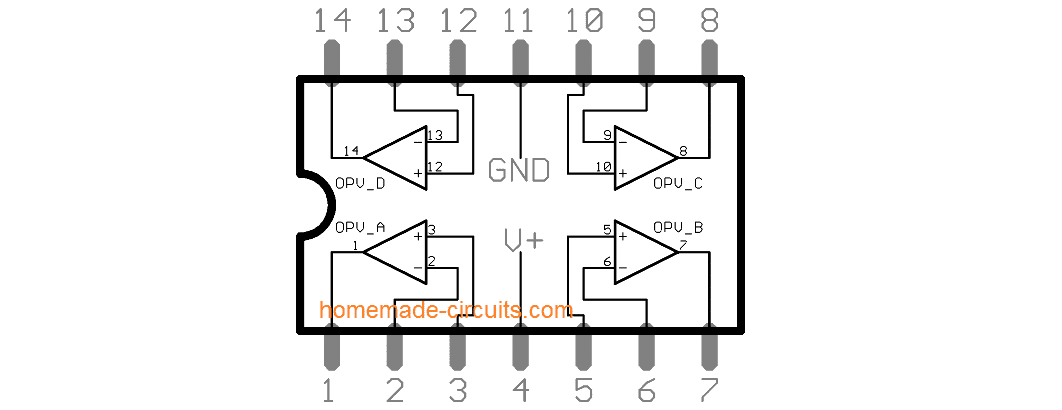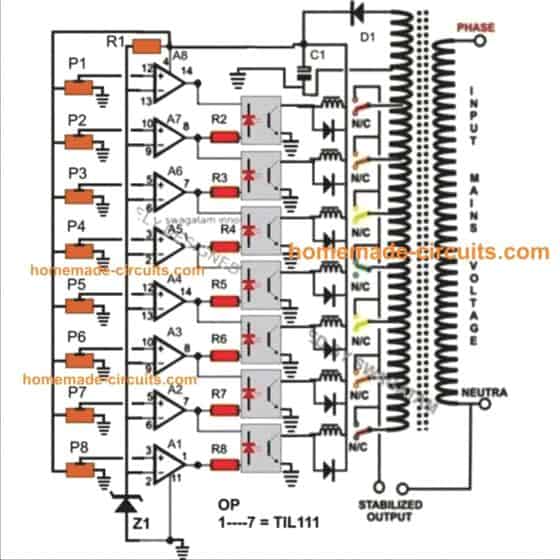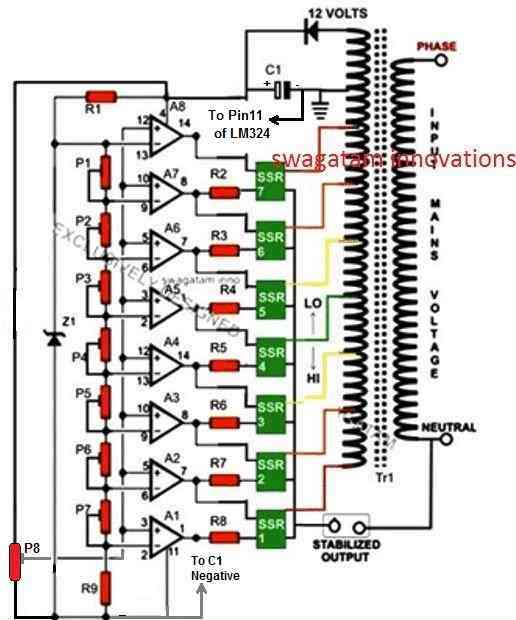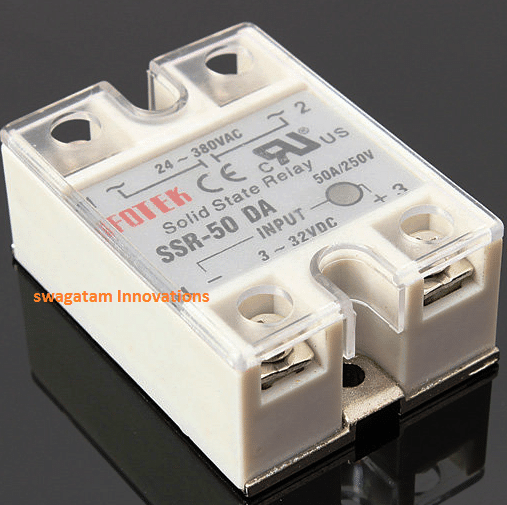Voltage stabilizer in the range of kVAs are powerful AC voltage stabilizer units specially designed for controlling and stabilizing high voltage fluctuations, for high power electrical equipment.
In this article I will explain an easy to build a 7 stage high wattage in the order of 5000 to 1000 watts stabilizer circuit which can be used for controlling our mains AC line fluctuations and for producing very accurate stabilized voltage outputs for our domestic electrical appliances.
Circuit Operation
The proposed Accurate 7 relay OpAmp Controlled Mains Voltage Stabilizer Circuit concept is rather very simple. It uses discrete opamps wired up as comparators to sense the voltage levels.
As can be seen in the diagram, each opamp's inverting inputs are provided with sequentially incrementing voltage reference levels through a series of presets which drops a certain amount of voltage across itself.
Each opamp compares this voltage with the common sample mains AC voltage level supplied to the opamps non inverting inputs.
As long as this sample voltage is below the reference level the respective opamps keep their outputs low and the subsequent transistor relay stages remain inactive, however in case the voltage levels tends to shift from its normal range, the relevant relays trigger and toggle the transformer taps so that the output is appropriately equalized and corrected.
For example if the input AC voltage tends to fall, the upper relays may get triggered connecting the relevant higher voltage taps with the output and vice versa in case the voltage shoots upwards.
Here the opamp output inter-connections makes sure that only one optocoupler and therefore only one relay gets activated at a time.
Parts List
- P1---P8 = 10 K Preset,
- A1---A8 = IC 324 (2 Nos)
- R1---R8 = 1 K,
- All diodes = 1N4007,
- All relays = 12 volts, 400 Ohms, SPDT,
- Opto Couplers are all = MCT2E or equivalent,
Transformer = Pink Tap is normal voltage tap, the upper taps are in the decrementing order of 25 Volts, while the lower taps are in the incremental order of 25 volts.
Full circuit diagram of the proposed Accurate 7-Stage OpAmp Controlled Mains Voltage Stabilizer.
IC LM324 Pinout Details

Circuit Diagram

Upgrading into a Solid State Version using SSR
The diagram below shows a rather simple voltage stabilizer design which can hold huge output power in the range of 5 to 10KVA. The use of SSR or solid state relays makes the output stage easy to configure and very accurate - thanks to the modern SSRs which are designed to trigger massive power in response to smaller input DC potentials.
Circuit Description
The proposed circuit of a simple high capacity automatic voltage stabilizer circuit is easy to understand. All the opamps are arranged in standard voltage comparator modes.
The presets P1 to P7 can be adjusted as per the required tripping points, which will correspond to the output SSR switching and the subsequent transformer tap selections.
The central green TAP is the normal voltage output, the lower TAPs gradually produce higher voltages while the upper TAPs are set for lower voltages.
These TAPs are chosen by the appropriate SSRs in response to the varying AC voltages, thus adjusting the output voltage to the appliances close to normal levels.
This circuit was asked by Mr. Alexandar and the SSR data was provided by him.
Parts List
- R1 to R9 = 1K, 1/4 watt,
- R10 = 10k 1/4 watt
- P1 to P8 = 10K preset,
- C1 = 1000uF/25V
- VR1 = 10K Preset,
- opamps = IC 324,
Transformer = Input 230volts or 120volts, Taps - incrementing/decrementing voltage levels (TAPs) as per individual specs.
SSR = 10KVA/230volts = output, 5 to 32 volts DC = input
Full circuit diagram of the proposed A Simple 5 KVA to 10 KVA Automatic Voltage Stabilizer Circuit @220 Volts, 120 Volts
Solid State SSR Voltage Stabilizer Circuit Diagram

SSR Image

Sir,
Can I use the above circuit for 1kva stabiliser?
If possible please how?
You can use it for any desired load, by upgrading the relay and the transformer specs appropriately.
Hi there,
Does your circuit require/benefit from an isolation transformer in case of failure?
The transformer used in this design is an auto transformer, it does not have an isolation.
A very informative and practical site for hobbyists. Was going through it for stable power supply ideas and some ideas are really useful. Please make a project (with principles explained) on IGBT based PWM controlled static voltage stabilizer (220 v stable output) for connecting to main home supply (5-10 KVA). Eagerly waiting for the same.
Thank you, and glad you liked the post. I will try to figure the concept you have suggested, and if it’s possible I would surely post the same in this blog.
Ing very grateful for your information I have the pcb but I need the 4-step stabilizer diagram with the cd4093 to know where each component goes. Thank you. Help me. Thank you.
No problem, you can refer to the following post for more info:
https://www.homemade-circuits.com/build-solid-state-scrtriac-controlled/
Swag, all right?
Thanks for your return.
I designed the entire circuit in a simulation software, but the control of the outputs in the trimpots is difficult, while the regulation of each one alters the other.
I designed a 220v transformer, first tape to power the circuit in 12v, tape 02 – 170v – tape 03 – 180v and so on until the final tape of 230v.
Do you have any tips to improve the situation?
I even tried to separate the trimpots so that there is individual voltage correction, but without success, thanks again.
Thank you Lucca, for updating the results.
Only two subsequent opamps will react with each other at a given instant, and this will happen sequentially depending upon the setting of the presets. The presets must be set so that the transitions happen sequentially. Also, only one opamp can be high at any given instant that makes the design quite foolproof.
You can probably try replacing the presets with calculated resistors with incrementing values so that the transitions are sharp and perfectly sequential in response to the voltage fluctuations.
One example using fixed resistors can be seen in the following article:
https://www.homemade-circuits.com/4-led-temperature-indicator-circuit/
Hello how are you? I found the project very interesting and I’m trying to build it. I made a test transformer with 8 tapes, input can vary from 150 to 230v, the tapes correct at 220+-3%, but I’m having some difficulties in the circuit. if i can send me an email so we can exchange ideas.
Hello, thank you and I appreciate your efforts in building this circuit, however troubleshooting a ferrite based inverter can be very difficult without analyzing it practically. Still I will try to help you as much as possible, you can ask your questions here.
Swag, Alright?
Where is the R10 located on the circuit?
Did you simulate this circuit in any program? If possible give feedback.
Hello Lucca,
You an ignore, it was probably present in one of the previous diagrams which was modified with the existing ones.
I have simulated these circuits with my knowledge and understanding and according to me there’s no way it cannot work….
I can’t comment on simulators since I never use them
Thanks for the feedback.
Is this transformer a ferrite or silicon core?
Iron core transformer.
hello Swag, in the above diagram, the value of zeiner diode z1 is not mentioned. what is the value sir.
Hello Olusegun, Z1 can be any value between 3V and 9V, for the reference voltage.
Hi Swag! I have a 10kva , 2 phase stabilier , which has magnetic relays (3 No’s.). The load current required is about 30 amps max. The transformer is step down type. Now I wish to replace the whole circuit with SSR based circuit. Could you please be kind enough to guide me providing the details.
Hi RP, I could not find any SSR having N/O and N/C contacts both, so I am not sure how it can replaced with a relay!
This could be thing maybe i waiting for, i am not a geek but tinker a bit,
i have a 7.5Kv manual voltage stabiliser, using for audio dj amplifier, but when there is sudden voltage swing blew the amp, hence want it MADE TO automatic voltage stabiliser- relay based, i have check the micro controller circuit online but it has only 4+1 relay out, in my manual stabiliser have 8 steps, so your CIRCUIT MAY DO? pls do communicate on my mail jj2apps@gmail.com
Glad you found the article useful. You can definitely give it is try, however the circuit being quite complex is actually not recommended for the newcomers.
thank you Swagatam for replying so quickly, never expected it! , i am interested in the ready microcontroller working kit. relay will buy locally. pls suggest
You are welcome John, however I do not have a microcontroller based circuit with me at this moment. Possibly, I may try to find it and post it in the above article soon
Circuit? No pls, complete board n tested. Need only buy relays. Thanks, if possible, do reply
OK, if I find an appropriate source, will let you know!
I adjusted my factory made stabiliser to lower the output voltage but now I want to readjust as before for high output voltage but couldn’t get it. Please Swag, assist Sir
Seun, without seeing the board it can be difficult to know which presets need to be adjusted and why they may not be working…
yes. that looks much better! lol
There is possibly a resistor missing from the bottom of VR1 to ground in my opinion since there is no voltage divider effect created by VR1 other than with the load to ground formed by the parallel inputs of the 8 op amps +input pins. VR1 is only 1K so a much lower resistor value than that of the 8 parallel +ve input pins would be required. I seriously doubt that this design will work without it since the zener is 6 v, the -ve inputs are between about 5.5 and 0.8 volt while the +ve inputs will be up at about 15v. Perhaps VR1 around 20k and the resistor to ground from it around 10K? R9 seems low at 1k as well. The taps should not be 25 volts apart. They should only be about 10 volts apart unless you live in an area with extraordinarily poor quality power!
Where i live being able to regulate mains inputs like 260 250 240 230 220 210 200 190 to the output you want such as 220 or 230 would be correct and the taps on the extreme ends would never be used. If you live in a rural area with a very long transmission line and extreme voltage drop you may need 15 v taps but it’s hard to see anywhere you would want 200 volts variance (8 times 25) as your range. The trimpots have to be adjusted so there is overlap and NEVER a state where all outputs are off unless Vin is very low and you want brownout protection. I would try : increase R9, add the resistor i mentioned, alter VR1 and lower the tap voltage. A couple of 0.1 uf ceramics from pins 4 and 12 to ground wouldn’t hurt either To bypass spikes and RF noise and protect the I.C. The transformer should have an overheating cutout in it to disconnect the whole thing so it can’t cause a fire in the event of malfunction such as two shorted ssr’s shorting the windings.
The preset itself is very much capable of providing a voltage divider effect right between 0 and the max supply voltage. Remember the op amp inputs are high impedance inputs so it really doesn’t mater whether you are using a 1k or a 10k, or a 100k. It is the ratio of resistance between the slider/positive and the slider/negative that matters.
You can add resistors at the positive side and negative side of the presets to squeeze the window of the adjustments, to make the adjustments a little easier, although that is not necessary.
Capacitors can be added across as many nodes as possible to protect against any form of spikes or transients…
i think you are looking at the wrong diagram. VR1 and the SSR’s dont exist on the first version. Im clearly looking at the second version so perhaps look again at my comments
Yes, the VR1 in the second diagram needed a correction, I have changed its name and configuration accordingly.
Hi sir.
Please help me with the new generation Stabilizer.
igbt based voltage stabilizer
Hi Amin, I do not have this circuit with me at this moment, but if I find I will post it for you….
Please provide a circuit for 220VAC and 110VAC stabilizer having an auto transformer with taping of 94V, 109V,127V, 148V, 171V, 199V, 215V, 231V with relays.
You can try the first circuit from the above article and customize the relay contacts as per the tappings of your transformer.
Hello Swagatam,
great works and thank you for being supportive to students especial on their project works.
I am one of your followers. My question is if you want 1P7S transformer winging coils how do get that from multisim.
Many thanks
Thank you Isaac, sorry I do not know much about it since I do not use simulating softwares very often
Thanks very much for your quick response swagatam. I will be counting on you for your coaching on a project I am currently considering to develop for my research.
God bless you.
Many thanks
Isaac
You are welcome Isaac!
Thanks a lot, Mr Swagatam. May God bless you. Please Sir, I want you to show me full video on how to make 1500w including battery charger. Thanks once again.
Thanks Taofeek, I presently do not have the video now but in future if I make one I will surely update it for you….
i was wondering if you have a 120 volt input and 120 volt output ac circuit stabilizer
what is the part number of transfomer..plz send that
Thank you for sharing
Hi sir, What is the value of C1 and the meaning of P.
Value of C1 can be 1000uF/25V
Happy New 2020, thanks for all your supports Swag. For this circuit, is it possible to use a small transformer of 14v to power the Ic circuit instead of tapping the 14v from the auto transformer. But the auto trafo will be used for the large volt tappings. Thanks
Wish you too a Happy 2020 Adeyemi. Yes that’s definitely possible.
Please, advise why pin 4 is of ic1 is not mentioned, IC near to SSR1..?
if we build a 5kv and output voltage is designed 230 v, upon full load, the output voltage will drop to 210v, so how we can keep the output voltage also stable in 230v…?
The position of pin4 is not important in the diagram, it can be seen near the top op amp, pin4 goes to the positive supply
if we build a 5kv and output voltage is designed 230 v, upon full load, the output voltage will drop to 210v, so how we can keep the output voltage also stable in 230v…?
For that you will have to use a transformer that’s rated at 3 times more wattage than the load, in your case use a 12000 watt transformer
Sir,
I am confused between triac and SSR, can you please what is main difference,
I saw a voltage stabilizer cicuit diagram by you using triac. please explain what is the differnce..TKS
Arun, An SSR is a complete module with all the necessary protections built-in…a triac alone may be more vulnerable to damage compared to an SSR.
Sir swaggatam.
Please I will need your help on a circuit, an AC ADAPTER,19v .3.42A,
Hi Ken,
You can tell me your requirement, if possible I’ll try to help!
use a laptop power supply. so easy to buy on ebay or any computer store
please,send transformer data sheets of 5kva and 10kva
Sorry, I don’t have it with at the moment!
Assuming a tap is at 170V the next will be at 195v(25v) increment, but the input voltage is at 180v, how will it handle it. Because 180v is in between the taps
Please check and learn how an auto-transformer is designed to work… then try to attach the auto transformer taps into the above circuit accordingly.
Pls can I get a circuit diagram for a 5kva Automatic voltage stabilizer
Hi my boss swag, this is kaluya moses from Uganda your old student / a follower.
Honestly, thank you for the wonderful job you doing to serve the world electronically God bless you . long live swag.
In fact price of electronic mr swag , I will would like to help me the type of sort ware you use to design or to make schematic diagrams/PBC.
Thank you Kaluya, I am glad you are liking my website! I use Corel-Draw for designing the schematics and PCBs.
Thanks a lot prince of electronics mr Swag, I still need much support from you because i have circuits to design and if at all I need someone to do it for me, what should I do? before I learn to do it myself. please advise me mr Swag. Thanks.
Thanks Kaluya, There are probably many PCB softwares online which you could try, but without learning them it could e difficult. Or you may be you can contact a PCB designer for the job.
Greetings to you my friend,swag.
I am very much interested to learn how to use coral draw,for pcb design.
what is the data of Z1 ?
you can use a 6V zener.
thz
Hello Dear Swagatam, Please can you guide me on how to setup the two opamps (lm324) for ensuring appropriate shooting/kicking of the relays without crash. Again, at what DC equivalent of 220VAC do I keep the pink (220VAC) tap swiched ON while other stay OFF and vice versa? Please help. Thanks.
Hi Kingsley, you just have to adjust the presets from bottom to the top in an incremental order, such that the lowest relay activates at the lowest voltage threshold, the second lowest at the second lowest threshold and so on until the top preset which activates the topmost relay at the highest voltage threshold..
The lowest threshold could be 150V, and the highest could be 300V.
Thank You very much my dearest electronics mentor! I sincerely do appreciate your effort towards keeping young electronic hobbyists updated. I will try the setup and get back to you with observations.
Thank You once again.
Your are welcome Kingsley, wish you all the best!!
hi swag.please help me with the diagram of electrical series testing board and how to use it.i think it is advisable when testing any short circuit problem.i saw it in youtube but i don’t understand hindi/urdu.thanx
Hi Dennis, for testing an electrical system where a short circuit could be possible, the best technique is to use a lamp in series with the supply. For example you can use a 100 watt series bulb and then freely test the system, if at all a short circuit happens, the bulb will light up preventing any kind of burning or fire hazard issues. This is the most basic idea for safely carrying out a short-circuit prone experiment, if your system is more complex or require a more sophisticated cut off system, then please specify your experiment I’ll try to solve it for you.
ok thanx.i’ll try it first.i want to try it in servicing a tv or any other electronic products.if i have a circuit that i don’t understand,please help me.thanx again.
Sure dennis, let me know if you face any problems.
hi swag,
what kind of transformer to use?
how many Ampere to meet 5kva – 10kva?
or just only any transformer do well?
thanks..
Hi candra, you will need a transformer which may have a 220V or 120V entry and several outputs producing higher than 220V/120V values in steps, and also lower values than 220V/120V in steps. you will have to contact a professional transformer designer and make to order it or try acquiring readymade from ebay or amazon.
for getting ampere, divide the wattage with the input voltage
ok. thanks
Sir,
Can you explain igbt based static voltage stabilizer with DSP control popular nowadays.If possible please post a circuit of it.
Nishant, I think I have a similar concept published in this website, you can find it at the end of this post
https://www.homemade-circuits.com/smps-mains-voltage-stabilizer-circuit/
here instead of a transformer I have recommended using large electrolytic capacitor which can add equivalent power to the load during low voltage situations.
any way to compensate for high voltage with an SMPS system? ie can you use a buck circuit to deal with spikes/over voltages?
Doug